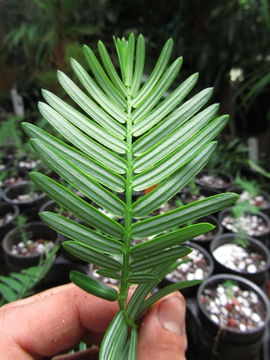| Citation |
|
Description |
Geographic Range [top]
Range Description: This species has a wide but scattered distribution in southeast Asia being recorded from southern and western China: Guangdong (Xingyi), Guangxi, Yunnan, SE Xizang [Tibet]; northern Myanmar [Burma]; northeast India: Arunachal Pradesh, Megalaya (Khasi, Jaintia, Mishmi Hills and Naga Hills), Assam (Manipur, Nagaland); northern Thailand; Viet Nam; and Lao PDR. The subpopulations in China and Thailand often only occur in low densities and in remote areas. Parts of the Indian subpopulation are sometimes referred to as C. griffithii. With such a wide range, the extent of occurrence is well in excess of the thresholds for a threatened listing and there is insufficient data available to calculate the area of occupancy.
Countries occurrence:
Native:
China (Guangdong, Guangxi, Tibet [or Xizang], Yunnan); India (Assam, Meghalaya, Nagaland); Lao Peoples Democratic Republic; Myanmar; Thailand; Viet Nam
Lower elevation limit (metres): 500
Upper elevation limit (metres): 2000
Range Map: Click here to open the map viewer and explore range.
Population [top]
Population: Although widespread, the species has become rarer. Due to its fragmented but widespread distribution it is difficult to make an accurate assessment of the current size of its global population. The subpopulation in China is estimated to number less than 15,500 plants, but it is not clear what proportion of these are mature individuals. In Guangdong province, only eleven trees are known, only one of which is a large tree. A continuing decline is suspected throughout its range due conversion of forests for agriculture and logging. Past decline is estimated to be between 30 and 50%, possibly higher.
Current Population Trend: Decreasing
Additional data:
?Continuing decline of mature individuals: Yes
?Population severely fragmented: Yes
Habitat and Ecology [top]
Habitat and Ecology: This widespread species occurs in mixed evergreen or deciduous forests, often in ravines. Its altitudinal range is from 500 to 2,000 m a.s.l. In China, trees are described as not reaching taller than 20 m (Flora of China 4: 87, 1999), but in Thailand trees up to 50 m tall have been reported. That maximum figure is certainly in need of verification, but trees to 30 m tall commonly occur in the undisturbed evergreen submontane rainforests of Thailand and Viet Nam. Cephalotaxus mannii can occur on both silicate rocks and limestone. It is often associated with Nageia wallichiana, Taxus sp., Dacrycarpus imbricatus and Podocarpus neriifolius on soils derived from the silicate rocks, and with Pseudotsuga sinensis, Nageia fleuryi, Pinus kwangtungensis, Podocarpus pilgeri, Taxus chinensis, Fokienia hodginsii, and Amentotaxus spp. on karst limestone in northern Viet Nam and southern China. In both types of habitat angiosperms play an important role with numerous tree and shrub species as well as epiphytes.
Systems: Terrestrial
Continuing decline in area, extent and/or quality of habitat: Yes
Generation Length (years): 50
Use and Trade [top]
Use and Trade: This conifer produces high quality insect resistant timber which is used for quality furniture, fine crafts and tool handles. The seeds and bark have medicinal uses in the treatment of leukaemia and lymphoma. The species is eminently suitable for use in horticulture, but is seldom seen in cultivation outside Asia. Some plants may be grown under its taxonomic synonym, C. griffithii Hook. f., which was originally described from the Mishmi Hills in Assam, India.
Threats [top]
Major Threat(s):
Throughout its range, C. mannii is restricted to small subpopulations in which the largest trees (to 30 m tall and over 100 cm d.b.h.) are often targeted for their timber. Stripping of bark is often fatal to the trees and this type of harvest is unsustainable. Logging is also unsustainable as this species grows slowly. The principal threat, however, is conversion of habitat to agriculture and resulting in severe forest fragmentation. There are not enough forest reserves of sufficient size and integrity to safeguard this species at present (Fu and Jin 1992, Nguyen et al. 2004). Fragmentation also makes the remaining stands more susceptible to natural disasters such as typhoons. It is likely that habitat reduction has accelerated in recent years.
Conservation Actions [top]
Conservation Actions: This species has been recorded in small subpopulations from more than 10 National Parks and nature reserves in Viet Nam including Bach Ma National Park, Ba Vi National Park Tam Dao National Park, Chu Mom Ray Nature Reserve and most of the protected areas around Bi Doup in Lam Dong. It has also been recorded from protected areas in other parts of its range e.g. Nakai Nam Theun National Conservation Area in Lao PDR.
It should be strictly protected throughout its range, and in areas where it is most threatened, propagation programmes should be established to supply material for plantation trials and to establish a living genebank, and seed storage should also be experimented with (Luu and Thomas 2004).
Citation: Liao, W. & Yang, Y. 2013. Cephalotaxus mannii. The IUCN Red List of Threatened Species 2013: e.T18625568A2804770. http://dx.doi.org/10.2305/IUCN.UK.2013-1.RLTS.T18625568A2804770.en. Downloaded on 16 March 2016.
Disclaimer: To make use of this information, please check the .
Feedback: If you see any errors or have any questions or suggestions on what is shown on this page, please provide us with feedback so that we can correct or extend the information provided
|

